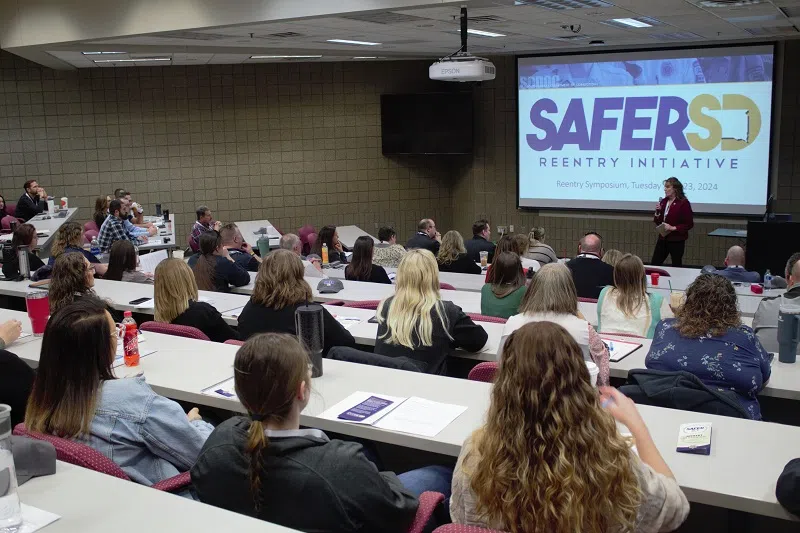OCTOBER 2024:
To help them transition back into their community, 12 minimum-custody male offenders housed in Sioux Falls are enrolled in a semester-long welding certificate program this fall through Southeast Technical College.
Corrections Secretary Kellie Wasko says they launched the Supportive Approach for Fostering Education and Reentry (SAFER) South Dakota reentry program earlier this year (2024). She says 95% of offenders will return to the community following their incarceration, and it’s “not only important but the right thing to do that we return them better than how we received them.”
DOC is exploring possible technical college Career and Technical Education program partnerships for female offenders at the state Women’s Prison in Pierre.
SAFER SD Program Manager Scott Day says statistics show that having education and technical skills gives an offender a better chance at successfully reentering a community. He says participants also complete the DOC’s PreP reentry programming during their enrollment period. Upon completing the program, participants can become certified through the American Welding Society.
Day says this is the fifth semester that state prison offenders have been approved to attend the welding class. He says participants also attend a Job Fair on the SETC campus that allows them to meet with potential employers in the welding field. Past cohorts have had an average graduation rate of more than 80% and a similar job placement rate upon completion of the program.
The DOC also offers CTE courses in precision machining through Lake Area Technical College for male offenders at Mike Durfee State Prison in Springfield. Offenders from the Rapid City Minimum Center can enroll in a plumbing course at Western Dakota Technical College.
The program is funded in partnership with the South Dakota Department of Labor.
MAY 2024:
The South Dakota Department of Corrections has begun the SAFER SD Reentry Initiative, designed to reduce recidivism and enhance public safety.
“This is an exciting, comprehensive approach to planning for reentry from prison back into society beginning at the time an offender first enters the DOC throughout their incarceration”, said Secretary of Corrections Kellie Wasko. “We need to give treatment and programming at the right dose, for the right duration, at the right frequencies, for the entire time offenders are with us, not just at the beginning and not just at the end.”
The Supportive Approach for Fostering Education and Reentry (SAFER SD) is based on the Transition from Prison to Community Model recommended as an evidence-based best practice by the National Institute of Corrections. The model establishes a continuum of assessment, classification, case planning, and programs designed to address the criminogenic risks and needs of offenders in prison and under community supervision and assists in establishing sustainable independence and providing the resources to successfully reintegrate into the community.
Reentry services will begin during the Admissions and Orientation process when an offender arrives at the DOC. During the institutional phase, offenders receive assessments to determine individualized programming needs that range from substance use disorder treatment to GED preparation. Programming needs are included in the offender’s case plan, which is managed by institutional case managers and reentry staff. DOC has completed training for case managers to use the Ohio Risk Assessment System (ORAS) and the Prison Intake Tool (PIT) and apply these assessment tools to all offenders entering the DOC and also retroactively for inmates who were already in prison.
The transition phase typically begins when an offender is within 12 months of release from prison. During this time, a reentry coach will be assigned to eligible offenders to prepare them for reintegration into the community. Reentry coaches will ensure that each offender is released with proper identification and a job placement packet that includes documentation of vocational and educational skills earned during incarceration to increase the likelihood of employability. They also administer a reentry curriculum to assessed offenders before release.
Offenders within 12 months of release who are identified with high transitional needs are referred to a transitional case manager who initiates a transitional meeting between the offender and reentry staff to identify a reentry plan. This involves coordination from a reentry corrections specialist, transitional parole agent, and transitional behavioral health staff.
Once the offender is released, the community phase of reentry begins. During this phase, the transitional parole agents work with high-transitional-needs offenders for the first 30-60 days upon release, assisting the assigned community parole agent with following through on the reentry plan. During this time, the community parole agent supervises the offender in the community until discharge is successful.
Another aspect of the SAFER SD initiative, as well as with the DOC’s strategic plan, is a focus on family reunification.
“One of the things that we see from offenders releasing from prison is an inability to have meaningful reintegration with their family or with other relationships,” said Wasko. “We are holding events in DOC facilities to help build healthy relationships with offenders and their families, prior to reentry.”
The family reunification events allow for the offenders to have increased contact and interactions with their loved ones over nationally celebrated holidays. The first family reunification events were held over the Easter weekend with a variety of activities at the DOC institutions. A schedule has been created to hold at least one event per quarter at all facilities.

DOC staff kick off of the SAFER SD Reentry Initiative in Sioux Falls April 23, 2024. Pictured is DOC Recovery Manager Scott Day.
Courtesy SD DOC.









Comments